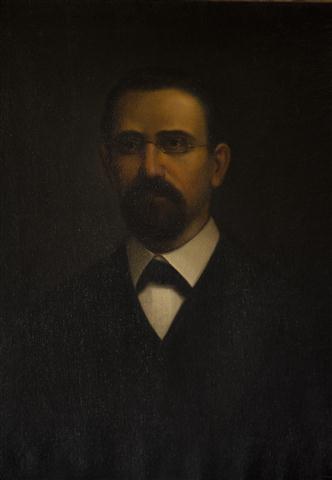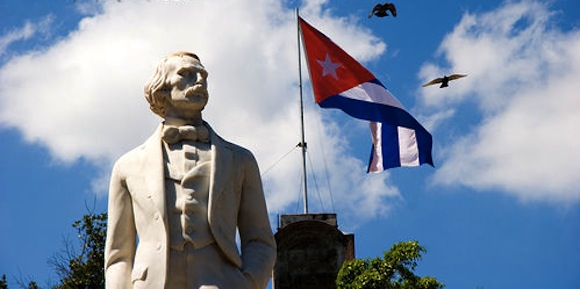Eusebio Leal Spengler ~ Historiador de la Ciudad de La Habana ~
“The soul of each country is its heritage”
Por: Vinicio Chacón / Tomado de Cubanow
Cuban historian Eusebio Leal Spengler delivered two conferences in Costa Rica about the permanent restoration process of Havana’s historic center and on the subject of national identity.
That city’s historic center was declared World Heritage in 1982; one year after Leal began the work to rescue the site.
Leal was born in 1942 and was a self-educated man since his youth; in 1974, he enrolled in the Faculty of Philosophy and History in the University of Havana to major in a bachelor’s degree in History, which he ended in 1979. He’s a Doctor in Historic Sciences and has master degrees in Archeological Sciences and Compared History of Latin America. He has also received Honoris Causa degrees in universities in Greece, Uruguay, Italy and Cuba.
Tell me about the Havana in which you grew up.
Very complicated, a great mirror of an unbalanced society where poverty from the countryside had nothing to do with urban splendor, where class differences were very clearly marked, with big prostitution neighborhoods fueled by American tourists of that period. It was a time of great Republican decadence, Batista’s dictatorship, the collapse of democratic governments. We were an underprivileged generation in the midst of a society that was falling apart due to the revolution, in 1959, which opened huge possibilities for study and personal training. Since then, the doors were open for me to work, thousands of jobs were organized and the difference between the city and the country was decreased.
Was your first work in the revolutionary regime during the literacy campaign?
After 1959, we began to see youths coming from the country to the city to study and we went to the country to alphabetize -I was then 16 years old. I was one of the 100 thousand youths that just by knowing how to read and write alphabetized one million persons. When we returned, going to study to achieve a greater goal was a social demand. Everything started for me then: reading eagerly, working and finally tests to validate subjects for the university. I walked a long way, in zigzag, through the mountain, while others had the chance to walk straight along an avenue. The important thing is that the revolution opened all the doors. I liked history and the world of collectibles so I chose history as a profession and, working in a museum as vocation. That’s how, in 1967, I started working in Havana City’s Museum and came to be the director of that institution eleven years later. In 1981, the challenge of restoring the historic center began and it still hasn’t ended.
What were the most pressing goals when the restoration works began?
What encouraged me most were the buildings that were being lost. But, life showed us that we had to struggle to keep the city as a whole rather than as one of separate elements; that a pure restoration project could not be feasible if it didn’t include the social aspect, i.e., the city with its dwellers. Then, it was necessary to have a much broader idea, more participative and popular, which took into account housing and health care. That’s why restoration has included the creation of geriatric centers or others which take care of disabled children.
Being a historian, what difficulties did the architectonic restoration work of Havana’s historic center pose?
Not many because I live surrounded by architects, there are more than one hundred working with me, as well as construction workers. At this stage, it’s a multidisciplinary job where the historian isn’t the only one taking part as the work’s coordinator and the animator of preaching for the social and useful awareness of keeping the cultural heritage; architects, engineers, lawyers, archeologists, and museologists also take part. In other words, it’s a multiple work because it’s not just about rebuilding, it’s also about undertaking a fair and equitable social development project which is looking for a better life for all those who live in the historic center.
In Cuba’s case where, due to international policies, it has very urgent needs and very few resources, how do you carry out a comprehensive restoration process such as this?
It’s in these circumstances when the preservation of cultural heritage becomes more pressing because, if they want to take away our body, they can also steal our soul, and the soul of each country is its tangible and intangible heritage. Cuba has given it a very high priority as it has also done with health care, education, and sports. The revolution’s greatest work is moral and ethic; as a part of that, the preservation of the historic heritage was very important, although from the economic point of view it was unaffordable. We faced the alternative of the entire country in the process of development, you have a huge cultural heritage but they tell you “privatize it because you can’t keep it; privatize archeology, the national parks and the museums, because it’s the only way to keep them running, because the State is always deficient.” That neoliberal sermon has been heard from morning to night. Old Havana contradicts all that; those who come to Cuba have a positive experience about restoration and all it entails. A model of self-management was created, by which the money the tourists visiting Old Havana leave goes directly to restoration works, a cycle of continuous movement that saves the city from oblivion and destruction. The State reserves the right to supervise but we carry out an autonomous management. In our case, the more tourism we have, the more restoration; the more restoration, the more tourism. That education has been unfailing and the project divides its money in three parts: one that goes directly to restoration works, another to social and communitarian development, and a third, a contribution to the nation, because without the homeland there is no Old Havana.
How do you size up the situation of architectonic heritage throughout your trips in Latin American and especially in Central America?
There are very outstanding people struggling everywhere. In this world, nobody has a monopoly on reason, the world is pluralist regardless of the homologizing trend of neoliberal globalization and many people have found ways to achieve a goal. But, cultural heritage is generally an orphan, above all because -paradoxically- the poorest countries are the ones that have greater tangible and intangible cultural heritage. It’s like a heavy burden on the backs of those states. If health care and education are priorities, how do you pay for museums, how do you rebuild a city?
In the field of heritage protection, what solution do you see for a Costa Rica which has lost a great part of its architectonic heritage?
There has to be a reaction convoked by a vanguard of thinking people. One of the great problems these countries have is to accept the challenge of globalizations even in aspects that are inevitable and how to achieve, at the same time, to preserve the autochthonous and the vernacular -which do not need to be just the colorful because we don’t have to appear only as puppeteers for international culture. We also have to brandish and proclaim our values without shame. We have to face the utopian but not fantastic idea of changing the world and, in this field of cultural heritage, the more conservative you are, the more revolutionary. Those of us who have been formed for this, have the great task of proclaiming the value of it all and, by doing that, we achieve consensus and win people over. I think that in the Cuban case, we’ve achieved that. The key is love and dedication, in politics, in education, in culture, in journalism or whatever, regardless of the difficulties. We know it’s very hard to have a dignified position in a world in which private interests set the rules of the game.
What attitudes have you found in academic professionals in the world, not only regarding Old Havana’s restoration but also concerning the whole universe of Cuban culture?
Cuba will always be the object of a great battle; you must remember that the media is in the hands of the empire and the news transnationals. But, in academic circles, in those of culture, Cuba has always had friends because they admire achievements such as sports and cinema. Generally speaking, Cuba is seen as very friendly and loving and there’s much curiosity about it -now more than ever since the so-called socialist bloc no longer exists. Cuba is carrying out the fiercest and longest battle in the history of this continent: the right of a people to make their own destiny and, if we have struggled so much for equality, we also struggle for singularity; Cuba is unique. We’re an island and a besieged island; we’re the continent’s Sparta. For instance, through Internet and films, young people see the sunny and glowing side of the capitalist world but they don’t know its rigor, the ideal of the market by which, for example, a doctor’s patient becomes his client. That’s why the revolution is perpetual and a battle of ideas is carried out.
Compartir


